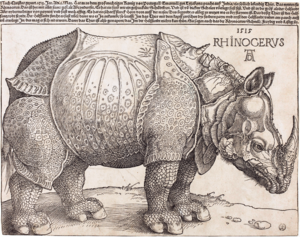
On 20 May 1515, an Indian rhinoceros arrived in Lisbon,
[a real big animal from the Far East.
It was a diplomatic gift in early 1514 to Afonso de Albuquerque
(unfortunately there was human disrespect for the unlucky beast)
a gift from Sultan Muzaffar Shah II, ruler of Cambay[modern Gujarat, in which they prohibit the sale of alcohol….calm down,
take it easy…...….nobody compels you to go to such place….
[or in such a town.
Albuquerque decided to forward the gift,
[known by its Gujarati name of genda, to King Manuel I of Portugal.
Nobody ever learned the reason the rhino was sent to the king,
[but it is more than likely than not, an act diplomatically allegorical.
A rhinoceros had not been seen in Europe since Roman times
[and that may have led the king to repeat the barbarity of a Roman dictator,
forcing the two innocent animals, rhinoceros and an elephant fight to death,
[considering himself a renovator...
___________________________________________________________________
* ''IT COULD BE OTHERWISE in verse''
Texts and Narration: Odysseus Heavilayias - ROTTERDAM //
Language adjustments and text adaptation: Kellene G Safis -CHICAGO//
Digital adaptation and text editing: Cathy Rapakoulia Mataraga - PIRAEUS
______________________________________________________________
*Rhino : A rhinoceros commonly abbreviated to 'rhino',
In early 1514, Afonso de Albuquerque, governor of Portuguese India, sent ambassadors to Sultan Muzaffar Shah II, ruler of Cambay (modern Gujarat), to seek permission to build a fort on the island of Diu. The mission returned without an agreement, but diplomatic gifts were exchanged, including the rhinoceros. At that time, the rulers of different countries would occasionally send each other exotic animals to be kept in a menagerie. The rhinoceros was already well accustomed to being kept in captivity.
At that time, the rulers of different countries would occasionally send each other exotic animals to be kept in a menagerie. The rhinoceros was already well accustomed to being kept in captivity. Albuquerque decided to forward the gift, known by its Gujarati name of genda, and its Indian keeper, named Ocem, to King Manuel I of Portugal. It sailed on the Nossa Senhora da Ajuda,[9] which left Goa in January 1515. The ship, captained by Francisco Pereira Coutinho,[11] and two companion vessels, all loaded with exotic spices, sailed across the Indian Ocean, around the Cape of Good Hope and north through the Atlantic, stopping briefly in Mozambique, Saint Helena and the Azores.
After a relatively fast voyage of 120 days, the rhinoceros was finally unloaded in Portugal, near the site where the Manueline Belém Tower was under construction. The tower was later decorated with gargoyles shaped as rhinoceros heads under its corbels.
Ιt had become something of a mythical beast, occasionally conflated in bestiaries with the "monoceros" (unicorn), so the arrival of a living example created a sensation. In the context of the Renaissance, it was a piece of classical antiquity which had been rediscovered, like a statue or an inscription.
The animal was examined by scholars and the curious, and letters describing the fantastic creature were sent to correspondents throughout Europe. The earliest known image of the animal illustrates a poemetto by Florentine Giovanni Giacomo Penni, published in Rome on 13 July 1515, fewer than eight weeks after its arrival in Lisbon. The only known copy of the original published poem is held by the Institución Colombina in Seville.
It was housed in King Manuel's menagerie at the Ribeira Palace in Lisbon, separate from his elephants and other large beasts at the Estaus Palace. On Trinity Sunday, 3 June, Manuel arranged a fight with a young elephant from his collection, to test the account by Pliny the Elder that the elephant and the rhinoceros are bitter enemies.The rhinoceros advanced slowly and deliberately towards its foe; the elephant, unaccustomed to the noisy crowd that turned out to witness the spectacle, fled the field in panic before a single blow was struck.

Artist Albrecht Dürer Year 1515 Type Woodcut
Dimensions 23.5 cm × 29.8 cm (9.3 in × 11.7 in)
Location This impression, National Gallery of Art, Washington
Dürer's Rhinoceros is the name commonly given to a woodcut executed by German painter and printmaker Albrecht Dürer in 1515. The image is based on a written description and brief sketch by an unknown artist of an Indian rhinoceros that had arrived in Lisbon in 1515. Dürer never saw the actual rhinoceros, which was the first living example seen in Europe since Roman times.In late 1515, the King of Portugal, Manuel I, sent the animal as a gift for Pope Leo X, but it died in a shipwreck off the coast of Italy in early 1516. A live rhinoceros was not seen again in Europe until a second specimen, named Abada, arrived from India at the court of Sebastian of Portugal in 1577, being later inherited by Philip II of Spain around 1580.
ELEGHOS... at history
No comments:
Post a Comment
Note: Only a member of this blog may post a comment.